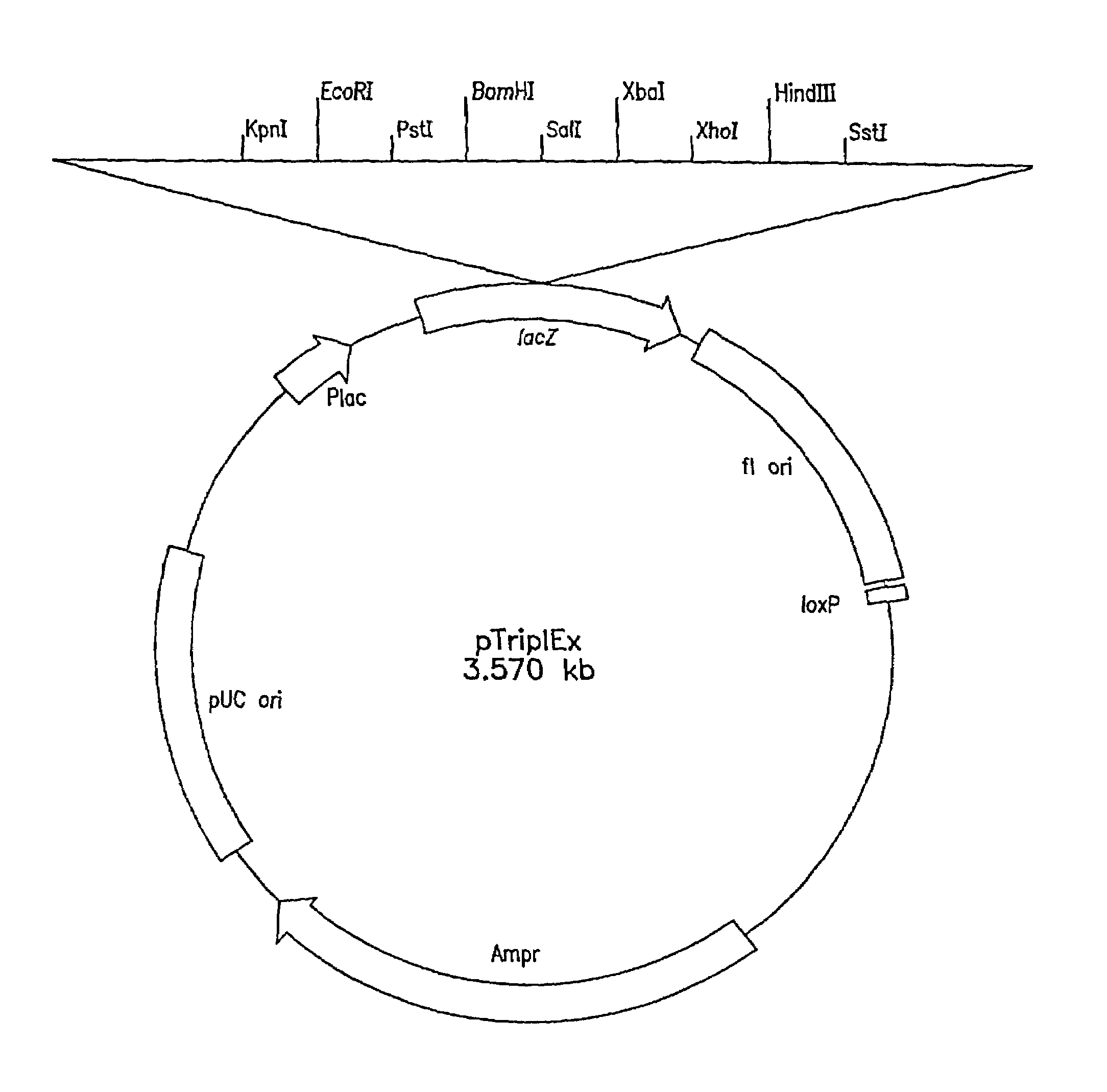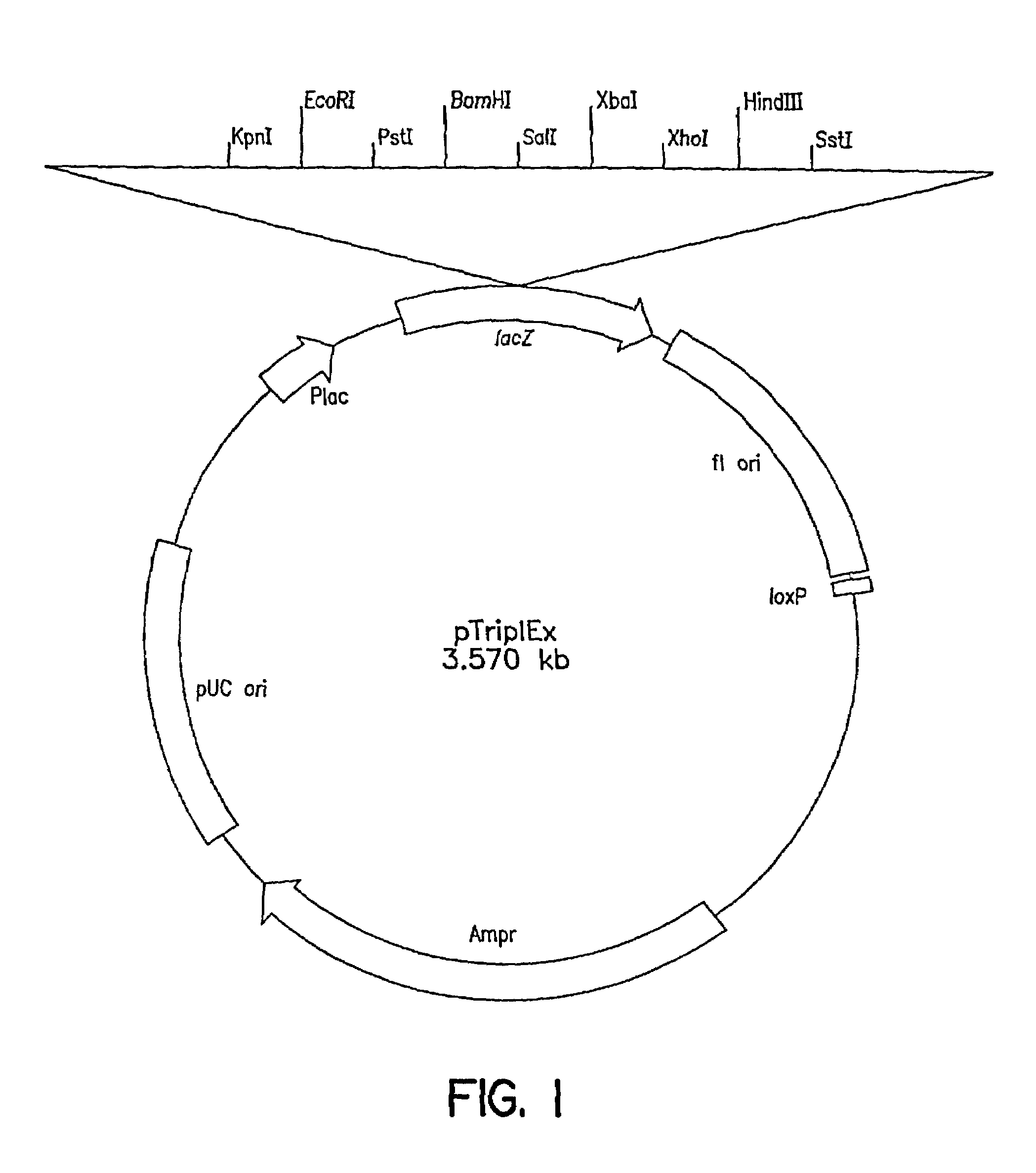Cytochrome P450 monooxygenase CYP52A2B from Candida tropicalis
a technology of cytochrome p450 and monooxygenase, applied in the field of new genes, can solve the problems of difficult synthesis, long purification steps, and shorter chain lengths, and achieve the effects of increasing the production of a cyp52a8a protein, and increasing the production of a dicarboxylic acid
- Summary
- Abstract
- Description
- Claims
- Application Information
AI Technical Summary
Benefits of technology
Problems solved by technology
Method used
Image
Examples
example 1
Purification of Genomic DNA from Candida tropicalis ATCC 20336
A. Construction of Genomic Libraries
[0115]50 ml of YEPD broth (see Table 9) was inoculated with a single colony of C. tropicalis 20336 from YEPD agar plate and grown overnight at 30° C. 5 ml of the overnight culture was inoculated into 100 ml of fresh YEPD broth and incubated at 30° C. for 4 to 5 hr with shaking. Cells were harvested by centrifugation, washed twice with sterile distilled water and resuspended in 4 ml of spheroplasting buffer (1 M Sorbitol, 50 mM EDTA, 14 mM mercaptoethanol) and incubated for 30 min at 37° C. with gentle shaking. 0.5 ml of 2 mg / ml zymolyase (ICN Pharmaceuticals, Inc., Irvine, Calif.) was added and incubated at 37° C. with gentle shaking for 30 to 60 min. Spheroplast formation was monitored by SDS lysis. Spheroplasts were harvested by brief centrifugation (4,000 rpm, 3 min) and were washed once with the spheroplast buffer without mercaptoethanol. Harvested spheroplasts were then suspended i...
example 2
Construction of Candida tropicalis 20336 Genomic Libraries
[0118]Three genomic libraries of C. tropicalis were constructed, two at Clontech Laboratories, Inc., (Palo Alto, Calif.) and one at Henkel Corporation (Cincinnati, Ohio).
A. Clontech Libraries
[0119]The first Clontech library was made as follows: Genomic DNA was prepared from C. tropicalis 20336 as described above, partially digested with EcoRI and size fractionated by gel electrophoresis to eliminate fragments smaller than 0.6 kb. Following size fractionation, several ligations of the EcoRI genomic DNA fragments and lambda (λ) TriplEx™ vector (FIG. 1) arms with EcoRI sticky ends were packaged into λ phage heads under conditions designed to obtain one million independent clones. The second genomic library was constructed as follows: Genomic DNA was digested partially with Sau3A1 and size fractionated by gel electrophoresis. The DNA fragments were blunt ended using standard protocols as described, e.g., in Sambrook et al, Molecu...
example 3
Screening of Genomic Libraries
[0121]Both λTriplEx™ and λZAP Express™ vectors are phagemid vectors that can be propagated either as phage or plasmid DNA (after conversion of phage to plasmid). Therefore, the genomic libraries constructed in these vectors can be screened either by plaque hybridization (screening of lambda form of library) or by colony hybridization (screening plasmid form of library after phage to plasmid conversion). Both vectors are capable of expressing the cloned genes and the main difference is the mechanism of excision of plasmid from the phage DNA. The cloning site in λTriplEx™ is located within a plasmid which is present in the phage and is flanked by loxP site (FIG. 1). When λTriplEx™ is introduced into E. coli strain BM25.8 (supplied by Clontech), the Cre recombinase present in BM25.8 promotes the excision and circularization of plasmid pTriplEx from the phage λTriplEx™ at the loxP sites. The mechanism of excision of plasmid pBK-CMV from phage λZAP Express™ ...
PUM
| Property | Measurement | Unit |
|---|---|---|
| Mass | aaaaa | aaaaa |
| Fraction | aaaaa | aaaaa |
| Fraction | aaaaa | aaaaa |
Abstract
Description
Claims
Application Information
 Login to View More
Login to View More - R&D
- Intellectual Property
- Life Sciences
- Materials
- Tech Scout
- Unparalleled Data Quality
- Higher Quality Content
- 60% Fewer Hallucinations
Browse by: Latest US Patents, China's latest patents, Technical Efficacy Thesaurus, Application Domain, Technology Topic, Popular Technical Reports.
© 2025 PatSnap. All rights reserved.Legal|Privacy policy|Modern Slavery Act Transparency Statement|Sitemap|About US| Contact US: help@patsnap.com



